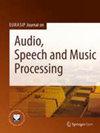困难语音自动识别技术综述
IF 1.9
3区 计算机科学
引用次数: 0
摘要
患有构音障碍的说话者经常难以准确地发音和有效地与他人交流。自动语音识别(ASR)是一种从构音障碍说话者中提取内容的强大工具。然而,狭义的ASR概念通常只涵盖处理声学模态信号的技术。在本文中,我们扩大了这一概念的范围,即泛化的ASR概念用于困难言语。我们的调查讨论了声学模态处理、发音动作处理和视听模态融合处理在识别困难语音中的应用。与以往对困难语音识别的调查相反,我们对这一领域的进展进行了系统的回顾。特别是,我们介绍了最先进的技术,以补充在困难语音识别的多模态融合时代的最新研究的调查。我们的调查发现,在困难语音识别任务中,视听融合技术比传统的ASR技术表现更好。然而,训练视听融合模型需要更多的计算资源,并且可用于困难语音的数据语料库有限。尽管存在这些挑战,最先进的技术显示出在未来进一步提高困难语音识别准确性的潜力。本文章由计算机程序翻译,如有差异,请以英文原文为准。
A survey of technologies for automatic Dysarthric speech recognition
Abstract Speakers with dysarthria often struggle to accurately pronounce words and effectively communicate with others. Automatic speech recognition (ASR) is a powerful tool for extracting the content from speakers with dysarthria. However, the narrow concept of ASR typically only covers technologies that process acoustic modality signals. In this paper, we broaden the scope of this concept that the generalized concept of ASR for dysarthric speech. Our survey discussed the systems encompassed acoustic modality processing, articulatory movements processing and audio-visual modality fusion processing in the application of recognizing dysarthric speech. Contrary to previous surveys on dysarthric speech recognition, we have conducted a systematic review of the advancements in this field. In particular, we introduced state-of-the-art technologies to supplement the survey of recent research during the era of multi-modality fusion in dysarthric speech recognition. Our survey found that audio-visual fusion technologies perform better than traditional ASR technologies in the task of dysarthric speech recognition. However, training audio-visual fusion models requires more computing resources, and the available data corpus for dysarthric speech is limited. Despite these challenges, state-of-the-art technologies show promising potential for further improving the accuracy of dysarthric speech recognition in the future.
求助全文
通过发布文献求助,成功后即可免费获取论文全文。
去求助
来源期刊

Journal on Audio Speech and Music Processing
Engineering-Electrical and Electronic Engineering
CiteScore
4.10
自引率
4.20%
发文量
28
期刊介绍:
The aim of “EURASIP Journal on Audio, Speech, and Music Processing” is to bring together researchers, scientists and engineers working on the theory and applications of the processing of various audio signals, with a specific focus on speech and music. EURASIP Journal on Audio, Speech, and Music Processing will be an interdisciplinary journal for the dissemination of all basic and applied aspects of speech communication and audio processes.
 求助内容:
求助内容: 应助结果提醒方式:
应助结果提醒方式:


